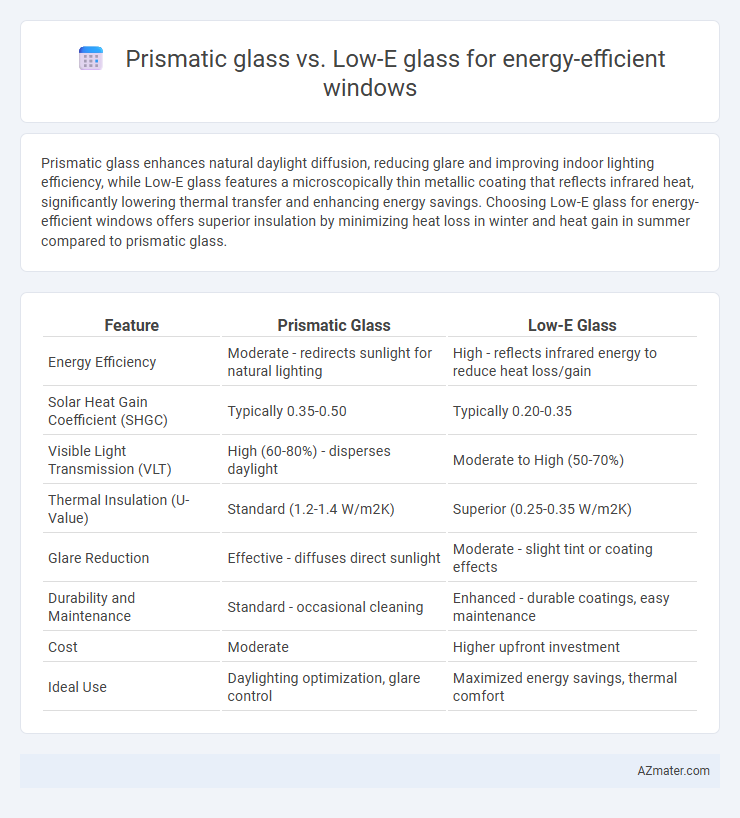Prismatic glass enhances natural daylight diffusion, reducing glare and improving indoor lighting efficiency, while Low-E glass features a microscopically thin metallic coating that reflects infrared heat, significantly lowering thermal transfer and enhancing energy savings. Choosing Low-E glass for energy-efficient windows offers superior insulation by minimizing heat loss in winter and heat gain in summer compared to prismatic glass.
Table of Comparison
| Feature | Prismatic Glass | Low-E Glass |
|---|---|---|
| Energy Efficiency | Moderate - redirects sunlight for natural lighting | High - reflects infrared energy to reduce heat loss/gain |
| Solar Heat Gain Coefficient (SHGC) | Typically 0.35-0.50 | Typically 0.20-0.35 |
| Visible Light Transmission (VLT) | High (60-80%) - disperses daylight | Moderate to High (50-70%) |
| Thermal Insulation (U-Value) | Standard (1.2-1.4 W/m2K) | Superior (0.25-0.35 W/m2K) |
| Glare Reduction | Effective - diffuses direct sunlight | Moderate - slight tint or coating effects |
| Durability and Maintenance | Standard - occasional cleaning | Enhanced - durable coatings, easy maintenance |
| Cost | Moderate | Higher upfront investment |
| Ideal Use | Daylighting optimization, glare control | Maximized energy savings, thermal comfort |
Introduction to Energy-Efficient Window Technologies
Energy-efficient window technologies utilize prismatic glass and Low-E glass to enhance thermal insulation and natural light control. Prismatic glass redirects sunlight to improve daylight penetration while reducing glare and solar heat gain. Low-E glass features microscopically thin metal coatings that reflect infrared energy, maintaining indoor temperature and lowering energy consumption.
What is Prismatic Glass?
Prismatic glass is a specialized glazing material designed with micro-structured surfaces that refract and diffuse sunlight to enhance natural illumination while reducing glare. Unlike Low-E glass, which primarily relies on thin metallic coatings to reflect infrared and ultraviolet rays for thermal insulation, prismatic glass optimizes light distribution to improve energy efficiency through daylight management. This unique optical property makes prismatic glass ideal for energy-efficient windows in buildings aiming to reduce artificial lighting use and control solar heat gain.
What is Low-E Glass?
Low-E glass, or low-emissivity glass, features a microscopically thin coating that reflects infrared energy while allowing visible light to pass through, significantly improving a window's insulation. This coating minimizes heat transfer, reducing energy loss and helping maintain consistent indoor temperatures, which enhances energy efficiency and lowers utility costs. Compared to prismatic glass, Low-E glass is specifically engineered to optimize thermal performance, making it a superior choice for energy-efficient windows.
How Prismatic Glass Improves Energy Efficiency
Prismatic glass enhances energy efficiency by redirecting sunlight deeper into interiors, reducing the need for artificial lighting and optimizing natural heat gain. Its micro-structured surface diffuses solar radiation, minimizing glare while maintaining thermal insulation. Unlike Low-E glass, which primarily blocks infrared rays, prismatic glass actively manages daylight distribution, contributing to lower heating and cooling energy consumption.
Benefits of Low-E Glass for Modern Homes
Low-E glass significantly enhances energy efficiency in modern homes by minimizing heat transfer, resulting in reduced heating and cooling costs. Its advanced coating reflects infrared heat while allowing natural light, improving indoor comfort without sacrificing daylight. Compared to prismatic glass, Low-E glass offers superior insulation, UV protection, and durability, making it a preferred choice for sustainable window solutions.
Comparing Light Transmission in Prismatic vs Low-E Glass
Prismatic glass enhances natural daylight by diffusing sunlight, improving indoor illumination without increasing glare, while Low-E glass reduces heat transfer by reflecting infrared energy and allowing visible light to pass. Prismatic glass typically provides higher visible light transmission (VLT) compared to Low-E glass, which may have slightly lower VLT due to its reflective coatings. For maximizing daylight entry with controlled glare, prismatic glass excels, whereas Low-E glass optimizes energy efficiency by balancing light transmission and thermal insulation.
Thermal Performance: Prismatic Glass vs Low-E Glass
Low-E glass offers superior thermal performance by reflecting infrared heat while allowing visible light to pass through, significantly reducing heat transfer and improving energy efficiency in windows. Prismatic glass primarily enhances daylighting by refracting light but provides limited insulation against heat loss or gain compared to Low-E coatings. When prioritizing thermal control and energy savings, Low-E glass is the more effective choice for window applications.
Cost Considerations and ROI
Prismatic glass typically has a higher upfront cost than Low-E glass due to its specialized light-diffusing properties but can enhance natural daylighting, potentially reducing artificial lighting expenses. Low-E glass offers a more immediate return on investment by significantly improving thermal insulation and reducing heating and cooling costs, making it a cost-effective choice for energy-efficient windows. Evaluating local climate conditions and energy prices is essential to determine which glass type delivers the best ROI for specific building projects.
Best Applications for Each Glass Type
Prismatic glass is ideal for spaces requiring controlled natural light diffusion and glare reduction, such as office interiors, healthcare facilities, and retail stores, enhancing daylight distribution without compromising privacy. Low-E glass excels in residential and commercial buildings needing superior thermal insulation and energy savings, effectively blocking infrared and ultraviolet rays to reduce heating and cooling costs. Selecting prismatic glass suits environments focused on visual comfort and aesthetic daylight effects, while Low-E glass prioritizes energy efficiency and thermal performance.
Which Glass is Right for Your Energy-Efficient Project?
Prismatic glass enhances natural daylight distribution by refracting sunlight deeper into rooms, reducing reliance on artificial lighting and lowering energy consumption. Low-E glass features a microscopically thin coating that reflects infrared heat while allowing visible light, improving insulation and minimizing heat transfer for year-round energy savings. Selecting the right glass depends on your project's climate and lighting needs: prismatic glass is ideal for maximizing daylight in darker spaces, while Low-E glass excels in insulation for both hot and cold environments.

Infographic: Prismatic glass vs Low-E glass for Energy-efficient window
 azmater.com
azmater.com